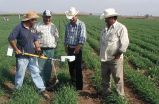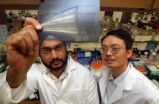(Press-News.org) Innovative UK technology is contributing to the development of a revolutionary digital stethoscope that could make it easier for GPs to spot the first signs of heart disease.
With Engineering and Physical Sciences Research Council (EPSRC) funding, a Queen Mary, University of London (QMUL) team has developed a computer-based technology that synchronises the various sounds collected by the new stethoscope and which make up a human heartbeat.
The sounds can then be analysed by an existing technique called ICA (independent component analysis), with data presented on a laptop or desktop computer in easy-to-understand graphs. These provide a visual representation of the heartbeat and any anomalies in it. Currently, such anomalies can be missed by doctors who aren't experts in cardiac care.
ICA can only analyse heartbeats if all the different sounds that make up an individual's heartbeat are brought together as one overall sound.
Like a conventional stethoscope, the new stethoscope captures four sounds one after another. The computer-based technology developed by the QMUL team then turns these separate sounds into one combined signal which ICA can then process. The QMUL synchronisation technology therefore plays a vital bridging role between the new stethoscope and ICA.
With conventional stethoscopes, the identification of a potential heart problem is completely reliant on the expertise and listening skills of the GP.
QMUL's technology was unveiled on 25th May at the 36th International Conference on Acoustics, Speech and Signal Processing held in Prague in the Czech Republic.
The overall stethoscope development project is an international collaboration led by Portugal's University of Porto and Centro Hospitalar Alto Ave, Guimarães.
"Heart disease is still the UK's number-one killer", says Professor Mark Plumbley, who has led the QMUL work. "Our work here is making a vital contribution to an invention that will help GPs identify heart problems before they become serious – even when patients come to surgery about a totally unrelated health matter. Early interventions not only help patients but also reduce the burden on healthcare resources."
As well as being suitable for use in GP surgeries, the stethoscope – called the DigiScope – will be ideally suited to outpatient clinics, accident & emergency units and other hospital departments where doctors are not necessarily cardiac specialists.
The DigiScope is designed to be used by doctors in exactly the same way as they use a conventional stethoscope. They position the end piece, in turn, on four different places on the patient's chest. However, with the DigiScope these four separate sounds are then transmitted wirelessly to a laptop or desktop and synchronised by the QMUL technology as if they were all transmitted simultaneously. They are then analysed using ICA.
With the new system, doctors can compare the visual graphs produced with 'normal' readings while the patient is there, or save the graphs and study them later. Or a second opinion on the data can be obtained, via the internet, from another doctor located miles away.
"It's the multidisciplinary character of this exciting international collaboration that has enabled it to produce such a promising outcome," says Professor Plumbley. "Two prototype DigiScopes are already in use to test their capabilities. The development will not remove the need for specialist cardiac units, it will simply make it easier to identify potential heart problems at an earlier stage."
###
Notes for Editors
The overall DigiScope initiative is a three-year, £120,000 project funded by the Fundação para a Ciência e Tecnologia (the Portuguese equivalent of the EPSRC).
The project is benefiting from additional co-operation from Brazil's Real Hospital Português in Recife.
The QMUL work has been undertaken as part of the 5-year 'Machine Listening Using Sparse Representations' project, which is receiving EPSRC funding of just over £1.2M.
About the DigiScope: in the ears of an experienced physician, a stethoscope yields important clinical information which can help an initial assessment of a patient's clinical condition and guide the subsequent need for more specialised examinations. This is particularly true in chest medicine (i.e. cardiology and pneumology), which is the reason why stethoscopes still maintain a key position in medicine in the modern era. However, auscultation (listening to internal sounds within the body via a stethoscope) is a hard skill to master. Heart sounds are of low frequency and the intervals between events are in the order of milliseconds, requiring significant practice for a human ear to distinguish the subtle changes between a normal and a pathological heart sound. The use of a digitally enhanced stethoscope, to train physicians to improve their basic skills in diagnosing and treating heart conditions, or as a tool for worldwide screening of specific heart pathologies, is an example of how state-of-the-art technology can be used to benefit people whatever socio-economic group they belong to and wherever they live. This drives the key objective of the DigiScope project: to develop the prototype of a digitally enhanced stethoscope, capable of automatically extracting clinical features from the collected data as well as providing a clinical second opinion on specific heart pathologies. The Principal Investigator is Miguel Tavares Coimbra, Assistant Professor in the Faculty of Science at the University of Porto. For more information see www.digiscope.up.pt
EPSRC is the main UK government agency for funding research and training in engineering and the physical sciences, investing more than £850 million a year in a broad range of subjects – from mathematics to materials science, and from information technology to structural engineering. www.epsrc.ac.uk
Queen Mary, University of London is one of the UK's leading research-focused higher education institutions with some 15,000 undergraduate and postgraduate students. Queen Mary has an annual turnover of £220 million, research income worth £61 million, and generates employment and output worth £600 million to the UK economy each year. As a member of the 1994 Group of research-focused universities, Queen Mary has made a strategic commitment to the highest quality of research, but also to the best possible educational, cultural and social experience for its students. http://www.qmul.ac.uk/
For more information contact:
Professor Mark Plumbley, Director – Centre for Digital Music, Queen Mary, University of London, tel: 020 7882 7518, e-mail: mark.plumbley@eecs.qmul.ac.uk
Images are available from the EPSRC Press Office, tel:
01793 444404, e-mail: pressoffice@epsrc.ac.uk
Image information:
Digiscope.jpg – 'the new DigiScope'
New sound synchronization technology holds the key to earlier diagnosis of heart disease
2011-06-03
ELSE PRESS RELEASES FROM THIS DATE:
Microscopic worms could help open up travel into deep space
2011-06-03
A space flight by millions of microscopic worms could help us overcome the numerous threats posed to human health by space travel. The Caenorhabditis elegans (C. elegans) have also given experts an insight into how to block muscle degradation in the sick and elderly.
The worms — from The University of Nottingham — were flown into space onboard the Space Shuttle Atlantis. They spent 11 days in orbit onboard the International Space Station more than 200 miles above the earth.
Many of C. elegans' 20,000 genes perform the same functions as those in humans. Experts in human ...
Safer sex: Study examines sexual communication in transgender community
2011-06-03
A new study from North Carolina State University shows that talking about safer sex is a complicated process for individuals in the transgender community. The finding may help efforts to promote safer sex practices in a community facing high HIV rates – and also sheds light on broader questions related to safer sex for everyone.
"The main reason for this study is the fact that we're seeing evidence of devastatingly high HIV prevalence rates in the transgender community," says Dr. Kami Kosenko, an assistant professor of communication at NC State and lead author of the ...
Fraser Yachts Exclusive - Fairer Winds Expected this Summer
2011-06-03
As the Mediterranean prepares for the summer season the yacht brokerage market is looking fairly healthy in contrast to this quarter in recent years. Supporting this resurgence are the annual boat shows that are beginning to see increased interest and enquiries through their continued efforts.
Although all areas of the business are showing equal improvements this cannot be said to be spread across Fraser Yachts' entire network worldwide however with some regions recovering quicker than others it would seem.
Most recently interest appears to be concentrated in the ...
Cognitive impairment seen in preschool children with epilepsy
2011-06-03
A recent study has shown that cognitive impairment is evident early on in preschool children with epilepsy, consistent with results of similar studies in older children. Age of onset of first seizure is a significant predictor of cognitive impairment according to this study—the first to evaluate cognitive impairment in children age three to six. The report is available in Epilepsia, a journal published by Wiley-Blackwell on behalf of the International League Against Epilepsy (ILAE).
Epilepsy is characterized by recurrent seizures that range from mild staring spells to ...
The blame game in work-family conflict
2011-06-03
INDIANAPOLIS – When the demands of work and family conflict, is the job blamed, is the family role blamed or is blame placed on both? And what are the consequences?
A new study by Elizabeth M. Poposki, Ph.D., assistant professor of psychology in the School of Science at Indiana University-Purdue University Indianapolis, is the first to explore day-to-day experiences in attributing this type of blame. The work examines individual incidents of work-family conflict and tracks how blame for this conflict is attributed.
Only three percent of those surveyed blamed both work ...
Farmer networks hold key to agricultural innovation in developing countries, Stanford study finds
2011-06-03
New technologies can improve agricultural sustainability in developing countries, but only with the engagement of local farmers and the social and economic networks they depend on, say Stanford University researchers. Their findings are published in the May 23 online edition of the Proceedings of the National Academy of Sciences (PNAS).
"Most people tend to think that technology information flows to farmers through a direct pipeline from scientists, but that isn't true," said lead author Ellen McCullough, a former research fellow at Stanford's Program on Food Security ...
Cause and potential treatment found for cancer drug's kidney toxicity
2011-06-03
AUGUSTA, Ga. – Scientists may have a way to make the powerful cancer drug cisplatin less toxic to the kidneys and more effective against some cancers.
The chemotherapeutic agent used in combination with other drugs for a variety of cancers, results in kidney damage or failure in about 30 percent of users, although the mechanism has been unclear. The most physicians can do today to protect the kidneys is advise patients to drink more water.
The relatively simple, highly reactive compound tends to accumulate in the kidneys, said Dr. Navjotsingh Pabla, postdoctoral fellow ...
Iron key to brain tumor drug delivery
2011-06-03
Brain cancer therapy may be more effective if the expression of an iron-storing protein is decreased to enhance the action of therapeutic drugs on brain cancer cells, according to Penn State College of Medicine researchers.
Malignant glioblastoma multiforme is a deadly brain tumor for which no long-term effective cure exists. Because drugs in the blood do not pass from the blood vessels to the brain, effective amounts of chemotherapy drugs do not reach the tumor. Increasing dosages damage normal brain tissue and cause significant neurological damage. These dosages also ...
Children eat more vegetables when allowed to choose
2011-06-03
This release is available in French and Spanish.
A gesture as simple as allowing children to freely choose the vegetables they want to eat helps to increase the consumption of these foods in children, as University of Granada has found. Moreover, his work suggests that the bitter taste of calcium, present in vegetables such as spinach, collard greens, cabbage, onions, chard or broccoli, can be a factor negatively influencing children's consumption of vegetables.
To carry out this experimental study, the authors analyzed the main factors determining vegetable consumption ...
Building a better dam map
2011-06-03
Humans have been building reservoirs and dams for thousands of years. Over the past few decades, their construction has spiked as our need to harness water – critical in flood control, irrigation, recreation, navigation and the creation of hydroelectric power – has grown. And while dams and reservoirs have important benefits, they can also be disruptive and costly to both humans and the environment.
A close assessment of critical environmental and social tradeoffs associated with dams and reservoirs within the global river network has been impossible because the data ...


